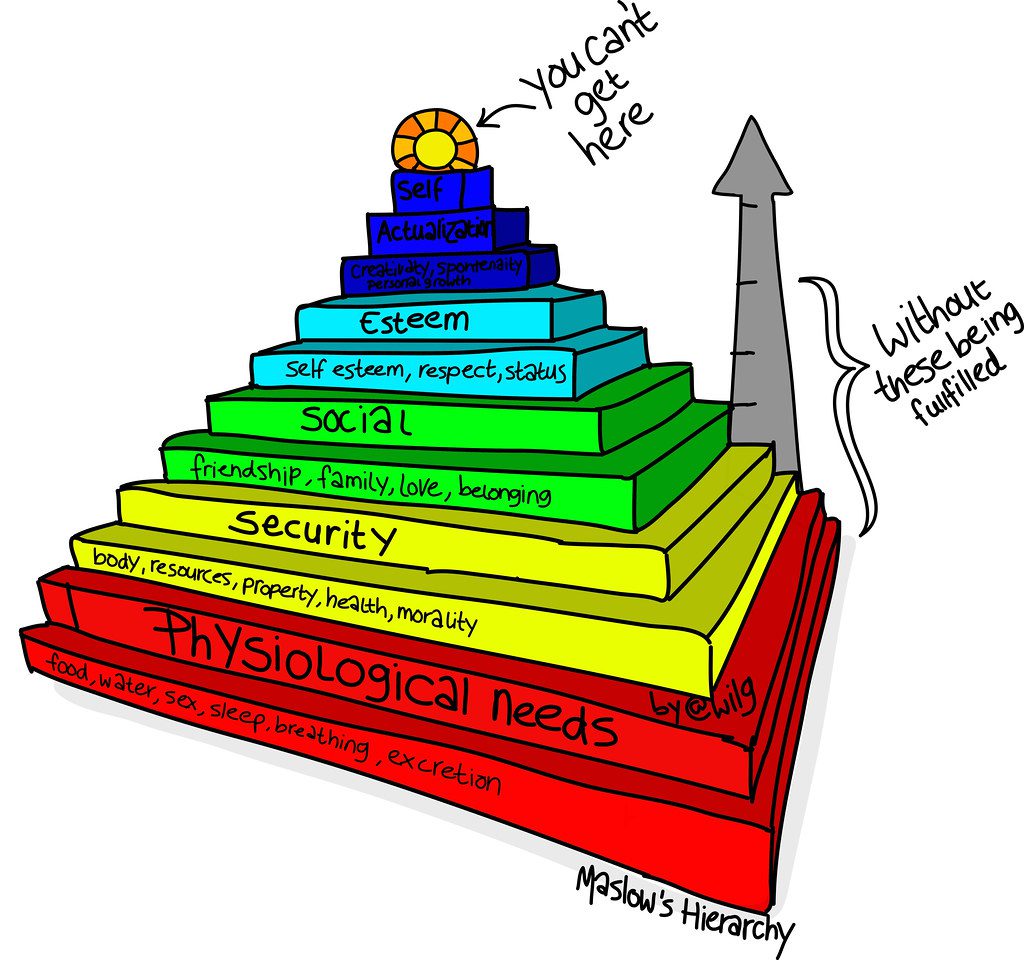Renowned psychologist Abraham Maslow revolutionized the understanding of human behavior with his theory of the hierarchy of needs, commonly known as Maslow's Pyramid. Proposed in his 1943 work, A Theory of Human MotivationThis theory postulates that human needs are organized in hierarchical levels, where certain basic needs must be satisfied before individuals can aspire to higher, more complex needs.
The pyramid is divided into five main categories, often represented as superimposed levels in a pyramid. From base to summit, these levels include physiological, security, social, esteem and, finally, self-actualization needs. According to Maslow, before an individual can begin to aspire to higher levels of satisfaction, he or she must first satisfy the lower needs, which are more pressing and fundamental.
The importance of this theory lies in its ability to provide an analytical framework that helps to understand the deep motivations of individuals. It is widely used in many fields, from psychology to business management, marketing and advertising. In marketing, for example, understanding what needs motivate a customer can help branders target their messages, design products that effectively meet those needs, and create advertising campaigns that resonate on a deeper emotional level with their audience.
In short, Maslow's Pyramid is more than just a psychological theory; it has far-reaching implications that cut across various sectors. It enables professionals to better understand behaviors, anticipate customer needs, and adapt their strategies accordingly, ensuring a more meaningful connection with their target audience. This framework is therefore essential for any practitioner wishing to harness human motivations to foster deeper engagement.
Introducing Maslow's Pyramid

Theoretical foundations
Abraham Maslow's historical and biographical background:
Abraham Maslow, born in 1908 in Brooklyn, New York, and died in 1970, was an American psychologist and pioneer of the humanistic approach. The son of Russian immigrants, his youth was marked by social isolation and intelligence, factors that had a profound influence on his career and theories. After earning his doctorate in psychology at the University of Wisconsin, Maslow taught at Brooklyn College and Brandeis University, where he developed the hierarchy of needs theory in the mid-20th century.
Description of the hierarchy of needs:
Maslow postulated that human needs are organized in a five-level hierarchy. This structure is often visualized as a pyramid, with the most fundamental needs at the base. Here are the five levels:
- Physiological needs: These are the most basic and vital needs, such as air, water, food, sleep and sex. Satisfying these needs is essential for individual survival.
- Safety needs: Once physiological needs are stable, security needs become predominant. These needs include physical and financial security, health and well-being, and protection from danger.
- Social needs: Corresponding to the need to belong, these needs encompass friendships and romantic relationships, community affiliations and the feeling of being accepted and appreciated by others.
- Esteem needs: After social needs have been met, esteem needs take over. These refer to self-esteem and respect from others, including self-confidence, competence, success and respect.
- Self-actualization needs: At the top of the pyramid, these needs represent personal fulfillment and the realization of one's potential. For Maslow, it's the quest for self-actualization that drives creativity, challenge and individuality.
Evolution of the theory
Changes and criticism over the years:
Since it was first conceptualized, Maslow's theory has been widely adopted, but also criticized. Critics have focused on its universality and rigid structure. Psychologists have questioned the strict order of needs, as well as the application of this theory to all cultures. For example, in some cultures, social needs may take precedence over security or even physiological needs.
Contemporary approaches and pyramid extensions:
In response to criticism, theorists have proposed adaptations to modernize Maslow's pyramid and make it more universally applicable. This includes the introduction of new needs, such as cognitive, aesthetic and even spiritual needs, which complement or reorganize the original structure. These developments reflect a more nuanced understanding of human motivations that goes beyond mere survival and material well-being, encompassing intellectual and spiritual development as essential components of human well-being.
By incorporating these nuances, Maslow's pyramid continues to be a valuable reference for professionals in various fields, including marketing, to develop strategies that effectively address human needs at different levels.
Applying Maslow's Pyramid to Marketing
Marketing and human needs
Analysis of how brands use the pyramid to segment their audience:
Maslow's Pyramid enables brands to understand and segment their audience by identifying the predominant needs of different consumer groups. By classifying basic needs to self-actualization needs, brands can create specific strategies designed to solve or meet these different levels of need, making their products or services more relevant and appealing to each targeted segment.
Practical examples of products or services targeting each level of need:
- Physiological needs: Food, beverage and housing companies exploit these needs. Nestlé, for example, offers a variety of food products that promise not only to satisfy hunger but also to provide balanced nutrition, thus satisfying the basic need for food.
- Safety needs: Home security brands like ADT or insurance companies like Allianz target this need with products that provide personal and financial security, enhancing consumers' peace of mind.
- Social needs: Social networks like Facebook and Instagram meet these needs by facilitating connection and interaction between users, strengthening community ties and a sense of belonging.
- Esteem needs: Luxury brands such as Rolex or Louis Vuitton target these needs by conferring high status and social recognition on their users through the ownership of their products.
- Self-actualization needs: Educational and life coaching companies, such as Coursera or Tony Robbins, offer programs and workshops that help individuals reach their maximum potential, promoting personal and professional growth.
Content strategies based on Maslow
Creating advertising messages that resonate with different levels of need:
Creating effective advertising messages requires a deep understanding of the needs targeted by Maslow's Pyramid. For example, an advert for life insurance might highlight the family's financial security (security needs), while a campaign for a new fitness app might emphasize how it helps users reach their highest levels of fitness (self-actualization needs).
Case studies: successful campaigns that have used Maslow's pyramid effectively:
- Nike - Just Do It: This iconic campaign targets the need for self-esteem and self-actualization, encouraging consumers to transcend their physical limits and achieve excellence through sport.
- Dove - Real Beauty Sketches: Dove used esteem needs to reach its audience by showing that every woman is beautiful in her own way, seeking to improve self-esteem through more positive body acceptance.
- LinkedIn - In It Together: LinkedIn taps into social and self-actualization needs by positioning its platform as a way for professionals to connect, learn, and grow in their careers, reinforcing a sense of professional community and personal development.
By applying Maslow's Pyramid, brands can not only better understand their customers' motivations, but also create messages that resonate deeply on an emotional level, increasing the effectiveness of their marketing campaigns.
Impact of Maslow's Pyramid on Customer Relations
Customer loyalty
Use the pyramid to improve customer satisfaction and loyalty:
Maslow's pyramid can be an effective tool for improving customer loyalty by targeting and satisfying their needs at different levels. A thorough understanding of customers' specific needs enables companies to personalize their services and products, which can lead to increased satisfaction and long-term loyalty.
- Practical example: A healthcare provider might offer customized programs that go beyond basic medical care, including mental wellness services and community activities that address patients' social and esteem needs.
Personalize interactions based on customers' dominant needs:
Segmenting customers according to hierarchy of needs enables more precise personalization of interactions. By identifying the level(s) of needs that are mainly unmet, brands can tailor their communication and engagement more effectively.
- Practical example: A bank could use customer data to determine whether a customer needs solutions that reinforce financial security (security level), or whether they are more interested in investment products that help them achieve financial autonomy (self-realization level).
Product development
Design products that meet multiple needs to maximize their appeal:
Producing items that simultaneously satisfy several levels of Maslow's pyramid can significantly increase their appeal. This not only satisfies immediate needs, but also builds a foundation for the satisfaction of future needs, making the product or service more integrated into the consumer's life.
- Practical example: A smartphone can be marketed not only as a communication device (social needs) but also as a tool for professional enhancement through educational applications (self-actualization needs).
Impact of satisfying higher needs (self-esteem and self-actualization) on brand perception:
Products or services that target and satisfy the needs at the top of the pyramid tend to create stronger positive emotions and deeper brand loyalty. Consumers perceive these brands as facilitators of their own growth and development, which can strengthen the customer-brand relationship and enhance brand reputation.
- Practical example: Online courses offered by platforms like Masterclass or Udemy that target the need for personal and professional development enable users to feel accomplished and valued, boosting their self-esteem and loyalty to the platform.
In conclusion, the application of Maslow's Pyramid in marketing and product development is not limited to identifying what customers want or need at a basic level; it encompasses a comprehensive strategy for engaging customers at different emotional and psychological levels, fostering a richer and more enduring relationship. This illustrates not only the importance of basic needs, but also the power of higher needs in creating long-term value for customers and brands.
Criticisms and limitations of Maslow's Pyramid
Review points
Discussions on prioritizing needs:
Maslow's theory has been widely debated, particularly concerning the strict hierarchy of needs. Critics have argued that the rigidity of this hierarchy does not always correspond to the behavioral reality of individuals:
- Flexible requirements : Needs do not always follow a strict hierarchical order. For example, in some situations, esteem needs may take precedence over security or even physiological needs, especially in cultures where honor and social status are paramount.
- Simultaneous needs : Research has shown that humans can seek the satisfaction of multiple needs simultaneously, contrary to the linear approach proposed by Maslow.
Cultural limitations of the theory:
Maslow's pyramid, initially developed on the basis of Western norms and values, has limitations when applied to different cultural contexts:
- Western centrism: The theory is often criticized for its Western bias, where independence and personal fulfillment are valued, which is not necessarily transposable to cultures that value communities and interpersonal relationships.
- Universality called into question : The universal relevance of the pyramid is called into question, particularly in non-Western cultures where social or community needs may be more dominant than individual needs for self-fulfillment.
Modern perspectives
Adapting the pyramid to today's globalized world:
Recognizing the criticisms, many theorists have proposed adaptations of Maslow's Pyramid to make it more globally applicable, reflecting diverse cultural and individual motivations :
- Level review : Modifications to the hierarchy to include interdependent needs or to reflect the values of a particular society, such as the inclusion of community needs before individual needs in some cultures.
- Dynamic pyramid : Conceptualization of a more flexible pyramid, where levels can overlap or be experienced in different orders according to personal and cultural circumstances.
New models and emerging theories influenced by Maslow:
Maslow's influence can be seen in the development of new theories that seek to complement or reformulate his vision of human needs to better adapt to contemporary realities:
- Self-determination theory: This theory suggests that beyond basic needs, autonomy, competence and relationship needs are essential for intrinsic motivation and psychological well-being.
- Multidimensional hierarchy : Some psychologists propose models in which needs are considered as spectrums rather than distinct stages, allowing a more holistic and nuanced approach to human motivation.
In sum, while Maslow's Pyramid continues to be a useful tool for understanding human motivations, its critics and alternative theories suggest that a more flexible and culturally inclusive approach is needed to navigate today's globalized and diverse landscape. These modern perspectives not only enrich our understanding of human needs, but also enable practitioners to better address and satisfy these needs in a broader context.











